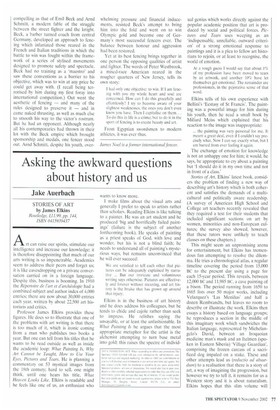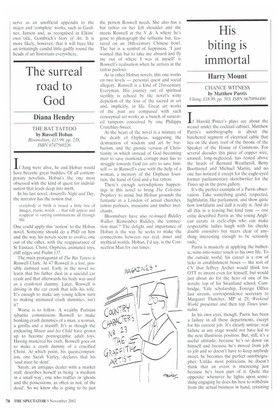Asking the awkward questions about history and us
Jake Auerbach
STORIES OF ART by James Elkins
Routledge, £11.99. pp. 144, ISBN 0415939437
Art can raise our spirits, stimulate our intelligence and increase our knowledge; it is therefore disappointing that much of our arts writing is so impenetrable. Academics seem to address their peers and forget us; it is like eavesdropping on a private conversation carried on in a foreign language. Despite this, business is booming. In 1910 the Repertoire de l'art et d'archeologie had a combined subject and author index of 4,000 entries; there are now about 30,000 entries each year, written by about 22,500 art historians and critics.
Professor James Elkins provides these figures. He does so to illustrate that one of the problems with art writing is that there is too much of it, which is ironic coming from a man who publishes two books a year. But one can tell from his titles that he wants to be read outside as well as inside the academic loop: What Painting Is, Why Art Cannot be Taught, How to Use Your Eyes, Pictures and Tears. He is planning a commentary on 53 mystical images from the 18th century; hard to sell, one might think, until one hears his title, What Heaven Looks Like. Elkins is readable and he feels like one of us, an enthusiast who wants to know more.
I make films about the visual arts and generally I prefer to speak to artists rather than scholars. Reading Elkins is like talking to a painter. He was an art student and he produced 'big and horrifically failed paintings' (failure is the subject of another forthcoming book). He speaks of painting as a priest speaks of God, with love and wonder, but his is not a blind faith; he needs to understand all of painting's mysterious ways, but remains unconvinced that he will ever succeed:
We are satisfied to tell each other that pictures can he adequately explained by narrative ... But our intricate and voluminous writing says otherwise. Pictures are effectively and forever without meaning, and art history is the bruise that has grown up around that injury.
Elkins is in the business of art history and he does address his colleagues, but he tends to chide and cajole rather than seek to impress. He relishes saying the unsayable, or at least the unfashionable. In What Painting Is he argues that the most appropriate metaphor for the artist is the alchemist attempting to turn base metal into gold; this raises the spectre of individ
ual genius which works directly against the popular academic position that art is produced by social and political forces. Pictures and Tears uses weeping as an 'indispensable, unreliable, outward criterion of a strong emotional response to paintings and it is a plea to fellow art historians to rejoin, or at least to recognise, the world of emotion.
At a rough guess I would say that about 1% of my profession have been moved to tears by an artwork, and another 10% have let themselves get emotional. The remainder are professionals, in the pejorative sense of that word.
Elkins tells of his own experience with Bellini's 'Ecstasy of St Francis'. The painting was a powerful image for him during his youth, then he read a small book by Millard Meiss which explained that his reaction to the image was inappropriate:
... the painting was very personal for me. It meant a great deal, even if I couldn't say precisely what. Now I can say exactly what, but I am barred from ever feeling it again.
The exchange of emotion for knowledge is not an unhappy one for him; it would, he says, be appropriate to cry about a painting but 'I should do it in my own time and not in front of a class.'
Stories of Art. Elkins' latest book, considers the problem of finding a new way of describing art's history which is both coherent and satisfies the demands of a multicultural and politically aware readership. (A survey of American High School and College art teachers recently revealed that they required a text for their students that included significant sections on art by women, minorities and non-European cultures; the survey also showed, however, that these tutors were unlikely to teach classes on these chapters.) This might seem an unpromising arena for entertainment, but Elkins has tremendous fun attempting to resolve the dilemma. He tries a chronological atlas, a regular timeline covering the period from 15,000 BC to the present day using a page for each 15-year period. This reveals, between 12,000 BC and 11,985 BC, a cave painting of a bison. The period running from 1650 to 1665 lists over 50 major works, including Velazquez's 'Las Menitias' and half a dozen Rembrandts, but leaves no room to describe or illustrate the work. Elkins then essays a history based on language groups; he reproduces a section in the middle of this imaginary work which sandwiches the Italian language, represented by Michelangelo's David, between an Iroquoian medicine man's mask and an Itelmen (spoken in Eastern Siberia) 'Village Guardian', comprising the frozen carcass of a sacrificed dog impaled on a stake. These and other attempts lead us (reductio ad absurdum) to a realisation that there is a story of art, a way of imagining the progression, but however we try to tell it, it remains for us a Western story and it is about naturalism. Elkins hopes that this slim volume will
serve as an unofficial appendix to the major and 'complete' works, such as Gardner, Janson and, as recognised in Elkins' own title, Gombrich's Story of Art. It is more likely, however, that it will buzz like an irritatingly candid little gadfly round the heads of art historians everywhere.



















































































































 Previous page
Previous page